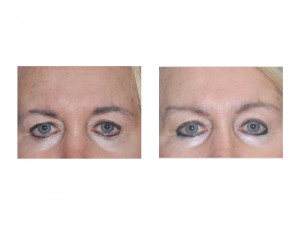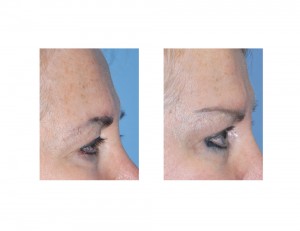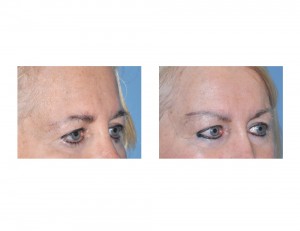Background: There are different types of browlifts that are done to help rejuvenate an aging eye area. The historic coronal browlift is done to lift up the entire brow arch through a long scalp incision way behind the hairline. An endoscopic browlift is performed using an endoscope through several small incisions just behind the hairline. A pretrichial browlift is performed through incision that parallels the edge of the frontal hairline. in front of the hairline. All have their unique purpose and indication for forehead rejuvenation.
One unique type of browlift is the temporal browlift. It is performed through an incision in the temporal scalp region at about 45 degrees upward from the tail of the outer brow. It is a limited browlift that just addresses the outer one third position or tail of the eyebrow. It is a very effective procedure for those patients, who are always women, that need only a lift in the outer one third of the brow. By lifting the brow tail, it gives the eye a more open appearance without creating a surprise look.
Temporal browlifts are smaller incision procedures that lift the outside portion of the eyebrows which serves decrease the hooding that occurs with aging on the outer aspect of the upper eyelid. It can also improve wrinkles at the corners of the eye (crow’s feet) as lifting the temporal brow will flatten the wrinkles as the skin and muscle are placed on stretch with the elevation. When combined with an upper blepharoplasty (eyelid tuck) it can really have a substantial anti-aging effect of the upper eyes.
Case Study: This 62 year-old female wanted to improve the look of her eyes which became more tired looking as she was getting older. She previously had upper and lower blepharoplasties several years previously but had subsequently developed hooding of the outer upper eyelids. (inadequate temporal resection??)


Case Highlights:
1) Browlifts in females often focus on creating a higher outer tail of the brow or lateral brow sweep.
2) A lateral canthopexy lifts up the outer corner of the eye to fix a drooping eye or to create an upward tilt to the eye.
3) The combination of a temporal browlift and lateral canthopexies can provide a rejuvenated periorbital look in a female. or even a ore exotic look if done more aggressively.
Dr. Barry Eppley
Indianapolis, Indiana



